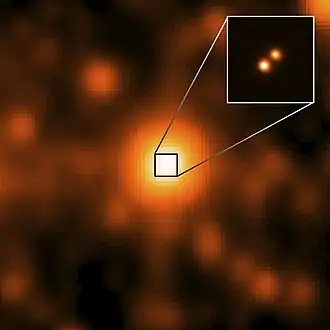| Observation data Epoch J2000 Equinox J2000 | |
|---|---|
| Constellation | Cygnus |
| Right ascension | 19h 35m 55.5743s[1] |
| Declination | +46° 41′ 15.957″[1] |
| Apparent magnitude (V) | 15.3 |
| Characteristics | |
| Spectral type | G0V |
| Astrometry | |
| Proper motion (μ) | RA: −3.443±0.049[1] mas/yr Dec.: −8.784±0.045[1] mas/yr |
| Parallax (π) | 0.8030 ± 0.0256 mas[1] |
| Distance | 4,100 ± 100 ly (1,250 ± 40 pc) |
| Details | |
| Mass | 1.038 ± 0.044 M☉ |
| Radius | 0.966 ± 0.042 R☉ |
| Temperature | 5962 ± 79 K |
| Metallicity [Fe/H] | 0.012 ± 0.003 dex |
| Rotation | 10.527±0.011 days[2] |
| Age | 1 ± 0.17 Gyr |
| Other designations | |
| Database references | |
| SIMBAD | data |
Kepler-66 is a star with slightly more mass than the Sun in the NGC 6811 open cluster in the Cygnus constellation. It has one confirmed planet, slightly smaller than Neptune, announced in 2013.
Planetary system
| Companion (in order from star) |
Mass | Semimajor axis (AU) |
Orbital period (days) |
Eccentricity | Inclination | Radius |
|---|---|---|---|---|---|---|
| b | 0.31 MJ | 0.1352 | 17.815815 | — | — | 2.80 R🜨 |
References
- 1 2 3 4 5 Brown, A. G. A.; et al. (Gaia collaboration) (August 2018). "Gaia Data Release 2: Summary of the contents and survey properties". Astronomy & Astrophysics. 616. A1. arXiv:1804.09365. Bibcode:2018A&A...616A...1G. doi:10.1051/0004-6361/201833051. Gaia DR2 record for this source at VizieR.
- ↑ McQuillan, A.; Mazeh, T.; Aigrain, S. (2013). "Stellar Rotation Periods of The Kepler objects of Interest: A Dearth of Close-In Planets Around Fast Rotators". The Astrophysical Journal Letters. 775 (1). L11. arXiv:1308.1845. Bibcode:2013ApJ...775L..11M. doi:10.1088/2041-8205/775/1/L11. S2CID 118557681.
- ↑ "KOI-1958". SIMBAD. Centre de données astronomiques de Strasbourg. Retrieved 14 February 2018.
External links
This article is issued from Wikipedia. The text is licensed under Creative Commons - Attribution - Sharealike. Additional terms may apply for the media files.


